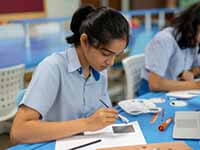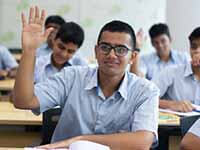If you’re moving to Singapore with your family, you may have questions about Singapore’s education system and which school would be best for your children. The more you know about schools in Singapore, the easier it will be for you to decide your child’s school for a meaningful, quality education with an excellent learning outcome.
Singapore’s education system is highly regarded with many options for all age groups, including primary school-age children. Children typically start at a play school/nursery or kindergarten at two and a half or three years of age, and primary school begins between the ages of six and seven and lasts until the ages of 11 or 12.
For international students, both public schools and private international schools are an option. However, each school system has its own admission requirements and application process. Here’s an overview of the schooling options if you’re new to Singapore.
Public schools
Singapore’s public schools are highly respected and offer high-quality education. Your family will have options ranging from kindergartens, primary to secondary education. Here we focus on primary schoolchildren.
To get into public school, your child must go through the application process, as required for expats. However, there is a limited number of spots available in public schools, and priority is given to Singapore citizens and permanent residents.
All international students of primary school age must undergo centralised admission tests to be enrolled for public schools. They can seek admission through Admissions Exercise for International Students (AEIS) for the following academic year or Supplementary Admissions Exercise for International Students (S-AEIS) in the same academic year.
Students seeking admission through AEIS or S-AEIS must go through the placement process after taking the test. Placement is based on vacancy in the school.
International schools
At present, Singapore is home to 62 international schools, according to the International School Advisor website. These schools offer a range of curricula and a diverse student body. Each has a large expat population. Typically, students must be at least six years old by January 1 of the year they start primary school.
Nevertheless, it is advisable to verify the age requirements with the admissions team of the school that interests you.
Also read: Bridge to Grade 2: How GIIS provides additional support to primary students
Here are a few key factors to consider to find out the right school for your child:
Curriculum. It is important to thoroughly evaluate the curriculum being offered to determine if it aligns with your child’s preferred learning style. Additionally, it is advisable to think about whether an international or native curriculum would be more suitable for your child.
If you are an expatriate, who intends to return to your home country in the future, it may be worthwhile to explore native curriculum options that are available in Singapore.
Infrastructure. With different options available in Singapore for international schools, it is essential to consider all factors, including the school infrastructure. Infrastructure encompasses everything, from the physical infrastructure like the building to facilities and resources like the teaching and classroom facilities, technology and learning resources, accessible and inclusive infrastructure like ramps, elevators, etc.
Beyond-the-classroom activities. Extracurricular and co-curricular activities give students an opportunity to grow and thrive beyond the classroom. During a tour with the particular international school of your choice, inquire about opportunities like sports/athletics, art, dance, among others.
Finding the right international school: What GIIS offers
GIIS is an all-through school, which means that students can study with us from grades K 1 through 12. The experience is designed to be seamless and consistent, which is beneficial for student progress. Students who are older than five up to 11-12 years can enrol in primary school.
For students who join mid-year in Grade 1, GIIS also offers bridge learning that helps them move to Grade 2. These students benefit from extra support to make the transition to Grade 2 when the next academic session begins. The bridge programme is designed to set students up for success and ensure that they feel comfortable when they start the next grade.
GIIS provides primary school students with a choice between the international International Baccalaureate Primary Year Programme (IB PYP) and the Indian Central Board CBSE curriculum. Students are encouraged to explore their interests within and outside of academics, including sports, arts and more.
It’s important to do your research and consider all the available options before making a decision. The best education for your child will suit their style of learning and help prepare them for the world outside school.
If you are keen to know more about GIIS, our admissions counsellors would be happy to meet with you, give you a tour and answer your questions. To find out more, please feel free to book a campus tour.

































